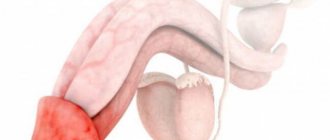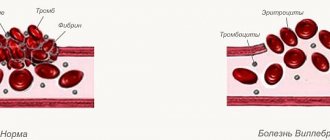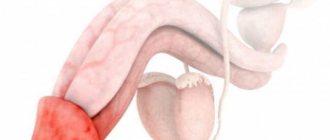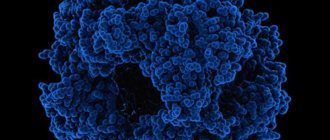Protein is the main building material in the human body. Normally, it is present in urine in minimal quantities, since it is well filtered by healthy kidneys. Deviations of indicators in the direction of increase may indicate the development of pathologies in an important organ. But sometimes an increased level of protein in the urine is observed due to an improper diet, against the background of stressful situations and other external influences.
Classification
Normally, healthy people can detect a small amount of protein - this is physiological proteinuria.
It is often observed in newborns, which is associated with the immaturity of the renal filter. Orthostatic proteinuria also occurs in children of preschool and school age, which appears when the child is in a vertical position (compression of the renal veins and blood stagnation occurs) and disappears when he assumes a horizontal position. In some situations, short-term (transient) proteinuria is possible:
- In case of hypothermia or overheating of the body.
- With nervous overstrain.
- With high fever.
- After prolonged physical exertion, during long walking (march proteinuria).
- After eating a large amount of protein food (alimentary proteinuria).
- After the doctor has performed a rough palpation of the kidneys, especially in children.
- With severe loss of fluid (dehydration proteinuria) with diarrhea, vomiting, sweating.
- After intense sun exposure (proteinuria solaris).
- After an epileptic seizure or concussion (centrogenic proteinuria).
According to severity, proteinuria is divided into:
- Minor – from 150 to 500 mg per day.
- Moderate – from 500 to 3000 mg per day.
- Massive - more than 3g per day.
By origin, pathological proteinuria is:
1.
Prerenal (“overload”).
Associated with high blood levels of low molecular weight proteins (paraproteins, monoclonal immunoglobulins) in malignant hematological pathologies or with blood stagnation in the renal vessels in heart failure.
2.
Renal.
The most common option. Increased protein excretion is caused by kidney pathology. Depending on the damage to one or another part of the nephron, renal proteinuria is divided into:
- glomerular (glomerular) - typical for diseases with damage to the glomerular apparatus of the kidneys (glomerulonephritis, diabetic nephropathy, nephropathy of pregnant women or arterial hypertension);
- tubular - characterized by impaired reabsorption of proteins in the renal tubules. Occurs with tubulointerstitial nephritis, taking nephrotoxic drugs, heavy metal poisoning, etc.;
- mixed - a combination of impaired filtration and protein reabsorption. It can be observed in the advanced stage of almost any organic kidney pathology.
3.
Postrenal.
The cause may be inflammatory or degenerative changes in the urinary tract - pyelonephritis, cystitis, bladder polyposis, bleeding from the urinary system.
Proteinuria in pregnant women
Help from our clinic specialists
The main thing to do is to monitor changes in your body and detect problems in a timely manner. Then consult a doctor who will conduct a thorough objective examination,, if necessary, prescribe additional tests, and tell you about the causes in order to eliminate not only the symptoms, but also the core of the disease.
Multidisciplinary specialists in Moscow are always happy to provide the required range of specialized care for patients of any age category, including consultation with a urologist and laboratory testing of urine. The clinic has several branches geographically scattered throughout the city, which allows you to choose the most suitable location for your visit.
| Prices for urologist services in Moscow | |
| Initial appointment with a urologist | 900 rubles |
| Repeated appointment with the urologist | 700 rubles |
| Calling a urologist to your home | 2,800 rubles |
| Kidney ultrasound | 1,000 rubles |
| Urine protein test | 600 rubles |
This article does not constitute medical advice and should not serve as a substitute for consultation with a physician.
Causes of prerenal proteinuria
This type of proteinuria is also called “overload”. It occurs in cases where the concentration of low molecular weight proteins in the blood is so high that passing through the kidney filter, they do not have time to be reabsorbed in the nephron tubules. The degree of protein excretion can be either slight or pronounced. Prerenal proteinuria develops in the following diseases:
- Monoclonal gammopathies.
Pathological proteins (paraproteins) are synthesized by plasma cells in large quantities in multiple myeloma, Waldenström macroglobulinemia, heavy chain disease, etc. - Hemolytic anemia.
In diseases accompanied by intravascular hemolysis (autoimmune hemolytic anemia, hereditary microspherocytosis, hemoglobinopathies), hemoglobin released from erythrocytes binds to the protein haptoglobin and enters the urine - Breakdown of muscle tissue.
A similar situation occurs with muscle breakdown (rhabdomyolysis). Rhabdomyolysis occurs with prolonged compression syndrome (crash syndrome), muscular dystrophies, and taking medications (statins).
With hemolysis and rhabdomyolysis, proteinuria occurs quite quickly and in the vast majority of cases disappears just as quickly. With paraproteinemia, it increases slowly over several years and begins to decrease only after courses of chemotherapy. Also very rarely, prerenal proteinuria can be caused by increased hydrostatic pressure in the glomeruli due to severe venous stasis. This is possible in severe chronic heart failure.
Causes of renal proteinuria
Glomerular proteinuria
This is the most common type of pathological proteinuria. An increase in protein excretion is associated with damage to the glomerular apparatus (glomeruli). Due to a defect in the renal filter, a large amount of blood plasma proteins, primarily albumin, enters the urine. The degree of proteinuria can be very pronounced (more than 3 g/l).
It often occurs together with other pathological urinary syndromes - hematuria, leukocyturia. Increased urinary protein excretion usually occurs gradually. Proteinuria regresses under the influence of specific anti-inflammatory therapy, but can persist for a long time, depending on the severity of the disease. Diseases in which glomerular proteinuria is observed:
- Primary glomerular pathology:
minimal change disease (common in children), membranous glomerulonephritis, focal glomerulosclerosis. - Secondary glomerular pathology:
diabetic nephropathy, kidney damage due to hypertension, nephropathy due to diffuse collagenosis (systemic lupus erythematosus, systemic scleroderma), systemic vasculitis (polyarteritis nodosa, granulomatosis with polyangiitis, Henoch-Schönlein hemorrhagic purpura).
More rare etiological factors of glomerular proteinuria include:
- Kidney cancer.
- Amyloidosis.
- Familial Mediterranean fever (periodic disease).
- Goodpasture's syndrome.
- Alport syndrome.
- Fabry disease.
- Membranous nephropathy in malignant neoplasms (breast cancer, lung cancer, oncohematological diseases).
- Imerslung-Gresbeck syndrome.
Tubular proteinuria
In this type of proteinuria, blood proteins that normally pass through the glomeruli are not reabsorbed by the renal tubules due to their damage. Therefore, protein losses are most often insignificant - no more than 1 gram per day. The rate of development of proteinuria depends on the cause; it can occur either acutely or gradually. Some diseases are quite difficult to treat, which is why proteinuria persists. Protein losses occur in congenital and acquired tubulopathies:
- Interstitial nephritis (due to taking nephrotoxic drugs such as aminoglycoside antibiotics, NSAIDs, antitumor drugs).
- Poisoning with salts of heavy metals (mercury, lead).
- Acute tubular necrosis.
- Polycystic kidney disease.
- Renal tubular acidosis (Fanconi syndrome).
- Vitamin D overdose.
- Renal transplant rejection.
- Obstructive uropathy.
- Sarcoidosis.
- Hepatolenticular degeneration (Wilson-Konovalov disease).
Can there be protein in a child's urine?
The function of a child’s kidneys is to filter the contents of the bloodstream from toxic and unnecessary components, the molecular size of which is definitely small.
Such substances include:
- uric acid;
- urea;
- indican;
- ammonium salts;
- creatinine, etc.
At the same time, useful and necessary components of the blood, namely glucose and amino acids, are absorbed back through the membrane of the renal tubules at the primary stage of filtration of urine, which forms plasma, in the absence of proteins with high molecular weight. During a daily interval, about 50 dm3 of primary urine is transported through the kidneys of a newborn, but secondary fluid is released through the system, determining the components of diuresis per day.
In an adult, about 180 dm3 of fluid is utilized per day at the primary stage of filtration, while the total volume of diuresis per day averages two liters. In childhood, this figure depends on the general health of the child, his weight and surface area. If the child’s condition is good and the child is in full health, there is completely no protein in his urine, but even minor traces of up to 0.03 g per liter are not an indicator of the development of pathology.
Causes of postrenal proteinuria
This type of proteinuria is caused by the release of inflammatory exudate rich in protein into the urine. This occurs more often with urinary tract infections (pyelonephritis, cystitis). Less commonly, the cause may be bleeding from the urinary tract caused by urolithiasis or bladder cancer. In general, protein losses are insignificant and rarely reach high values. Often combined with leukocyturia, bacteriuria or hematuria. In case of UTI infections, proteinuria begins to disappear already at the beginning of antibacterial therapy.
Preparation
In order to reduce the likelihood of receiving false data, you need to properly prepare for the analysis. The day before collecting urine, you should completely exclude foods that can change the color of urine from your diet. You also need to minimize the amount of fatty, smoked and very sweet foods. It is also necessary to give up alcohol and medications, including vitamins and dietary supplements.
Only the morning average portion is suitable for analysis. It should be collected in sterile disposable containers. They can be bought at a pharmacy very cheaply. Special containers are always available in stock. Urine should not be stored for more than two hours, otherwise the reliability of the results will be reduced. It is important to exclude any foreign substances from entering the urine that will be examined.
Diagnostics
Detection of proteins in the urine requires immediate contact with a general practitioner or nephrologist to determine the cause. To differentiate physiological and pathological proteinuria, when interviewing the patient, it is clarified what preceded its appearance, for example, high fever, intense physical activity, and intake of high-protein foods. Anamnestic data, such as whether the patient has a diagnosed chronic disease or the use of medications, is extremely important.
A physical examination is also carried out - measuring blood pressure, checking the skin for peripheral edema, Pasternatsky's symptom. If an autoimmune rheumatological pathology is suspected, the joints are carefully examined for swelling, redness, limitation or pain in movement.
Traditionally, during the initial examination, the determination of proteins in the urine is performed as part of a general urinalysis. It should be taken into account that the test strips used in OAM have some features:
- If urine pH is high or if you are taking iodine or antimalarial drugs, a false positive result is possible.
- The reagent zone of the test strips is more sensitive to albumin and extremely low sensitive to other proteins - beta-2 microglobulin, immunoglobulin G. Bence-Jones protein, characteristic of multiple myeloma, is not detected by this method at all.
To establish the correct diagnosis, studies can be prescribed to more accurately determine the type of proteins excreted in the urine and the severity of proteinuria:
- Daily urine protein
. This analysis provides more reliable information about the level of protein loss. - Protein/creatinine ratio.
Due to the laboriousness of collecting urine during the day, this method can serve as a full-fledged analogue, since the concentration of creatinine in urine is a fairly stable indicator. - Albumin/creatininone ratio.
Used to diagnose microalbuminuria. Often prescribed to patients with diabetes to monitor the onset of diabetic nephropathy. - Electrophoresis of serum and urine proteins.
In this analysis, proteins are separated into fractions, which allows the predominant type of protein to be assessed. An increase in the content of beta-2 microglobulin indicates tubular pathology, alpha-2 macroglobulin indicates a postrenal type of proteinuria. Multiple myeloma is characterized by an increase in monoclonal immunoglobulins (high M-gradient). - Determination of Bence Jones protein.
This protein is an immunoglobulin light chain secreted by tumor plasma cells. Its detection indicates multiple myeloma or Waldenström's macroglobulinemia. - Immunofixation of urine proteins.
Prescribed for suspected paraproteinemia. The study reveals a high concentration of varieties of immunoglobulin light chains (gamma, lambda, kappa). - Calculation of the selectivity index.
To assess the severity of glomerular proteinuria, the content of proteins with low (albumin, transferrin) and high molecular weight (immunoglobulin G) is determined. The predominance of high molecular weight proteins indicates severe damage to the glomerular apparatus, which requires more aggressive anti-inflammatory therapy.
The following studies are also carried out to clarify the diagnosis:
- Blood tests.
A general blood test may show nonspecific signs of chronic inflammation - decreased hemoglobin levels, leukocytosis, increased ESR. A biochemical blood test reveals an increase in the concentration of urea, creatinine, and C-reactive protein. Nephrotic syndrome is characterized by a decrease in total protein, albumin, and hyperlipidemia. - General urine analysis.
Other indicators of TAM, such as hematuria, bacteriuria, leukocyturia, often help in differential diagnosis. On microscopic examination of urine sediment, the presence of renal epithelial cells indicates the renal type of proteinuria; altered morphology of erythrocytes is characteristic of glomerular pathology. - Immunological studies.
In autoimmune rheumatological diseases, increased levels of rheumatoid factor and other autoantibodies (anticytoplasmic, antibodies to DNA, topoisomerase) are found in the blood. - Ultrasound/CT scan of the kidneys.
An ultrasound or CT scan of the kidneys may reveal changes in the renal parenchyma, expansion of the collecting system, the presence of cysts or stones. - X-ray.
In patients with rheumatic diseases, radiography of the affected joints often shows a narrowing of the joint space and periarticular osteoporosis. In multiple myeloma, x-rays of flat bones (especially the skull bones) show typical areas of osteolysis and osteodestruction. - Bone marrow examination.
If the patient has clinical and laboratory signs of paraproteinemia (Waldenström macroglobulinemia or multiple myeloma), confirmation requires a bone marrow biopsy, which reveals plasma cell infiltration, stromal fibrosis, and immunophenotyping to evaluate the expression of tumor markers (CD19, CD20, CD38).
Diagnosis of proteinuria
Features and indications for analysis
Nowadays, when analyzing total protein, a chemical examination of urine is used using automatic analyzers using the dry chemistry method. Before reaching adulthood, the norm is the complete absence of protein in the urine of the substance. This is because the permissible amount of the substance is 0.02 g/l, so it cannot be detected by the quality samples used. Protein in urine in older men and women should be less than 0.14 g/l.
If the first analysis confirms the presence of protein in the urine above normal, then a repeat test is required. This will eliminate accidental errors.
A general urine test is performed during any examination of patients. A study is mandatory if there are symptoms of nephropathy. In particular these are:
- The occurrence of edema.
- Unreasonable weight gain.
- Development of arterial hypertension.
- Change in urine color.
- Decreased urine output.
- Increased fatigue.
Research is also prescribed when diagnosing various diseases that affect different organs. For example, the analysis must be done in a comprehensive diagnosis of diabetes mellitus. It will allow more accurate diagnosis of various systemic connective tissue diseases.
Protein levels in the urine should be monitored at certain intervals if renal failure, hypertension, or obesity are confirmed. It is recommended to get tested regularly when you reach the age of 60 and if you smoke.
Correction
Conservative therapy
There are no independent methods for correcting protein loss in urine. It is necessary to treat the underlying disease. Short-term proteinuria resolves on its own and does not require any therapy. Orthostatic proteinuria in the vast majority of children disappears upon the onset of puberty, sometimes persisting until 18-20 years of age.
Patients with diabetes are prescribed a strict diet with limited foods high in easily digestible carbohydrates and animal fats. In case of interstitial nephritis provoked by taking nephrotoxic medications, their immediate withdrawal is necessary. Also, for various pathologies that cause proteinuria, the following medications are used:
- Insulin and hypoglycemic drugs.
For type 1 diabetes, daily injections of short- and long-acting insulin are required. For type 2 diabetes, hypoglycemic agents are prescribed - biguanides (metformin), sulfonylurea derivatives (glibenclamide), DPP-4 inhibitors (vildagliptin). - Antibacterial drugs.
For pyelonephritis, the drugs of choice are penicillin antibiotics (amoxicillin) and cephalosporins (ceftriaxone). For cystitis, fosfomycin trometamol is effective. - ACE inhibitors.
This group of drugs (lisinopril, perindopril) has a nephroprotective effect and is prescribed to all patients with nephrotic syndrome, especially to patients with diabetic nephropathy. - Glucocorticosteroids.
Hormonal agents (prednisolone, methylprednisolone) have anti-inflammatory and immunosuppressive effects. They are used in the treatment of glomerulonephritis and almost any rheumatological pathology. - Cytostatics.
Cytostatic drugs (azathioprine, cyclosporine) are used for severe forms of glomerulonephritis, necrotizing vasculitis, when steroid monotherapy is ineffective. - Chemotherapy.
Patients with confirmed paraproteinemia are shown courses of chemotherapy. Combinations of alkylating drugs (chlorambucil), nucleoside analogues (fludarabine) and monoclonal antibodies (rituximab) are prescribed. If the above agents are ineffective, thalidomide and bortezomib are used.
Surgery
For kidney cancer or polycystic disease, the main type of treatment is surgery (laparoscopic or open) - partial nephrectomy or total nephrectomy. Some patients with Waldenström's macroglobulinemia or multiple myeloma are candidates for hematopoietic stem cell transplantation.
References
- Nastausheva, T.L., Sitnikova, V.P., Shvyrev, A.P. and others. Proteinuria in children and adolescents: genesis, diagnostic algorithm, principles of therapy. Nephrology, 2011. - No. 2.
- Trukhan, D.I., Bagisheva, N.V., Goloshubina, V.V. and others. Differential diagnosis of urinary syndrome: proteinuria. International Journal of Applied and Documentary Research, 2016. - No. 12(7). — P. 1203-1207.
- Baranov, A.A. Clinical guidelines for providing medical care to children with nephrotic syndrome, 2015. - 11 p.










